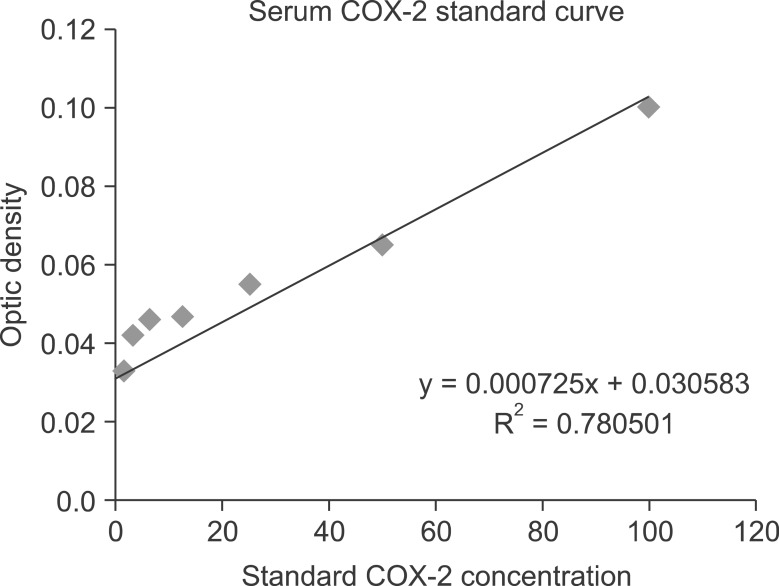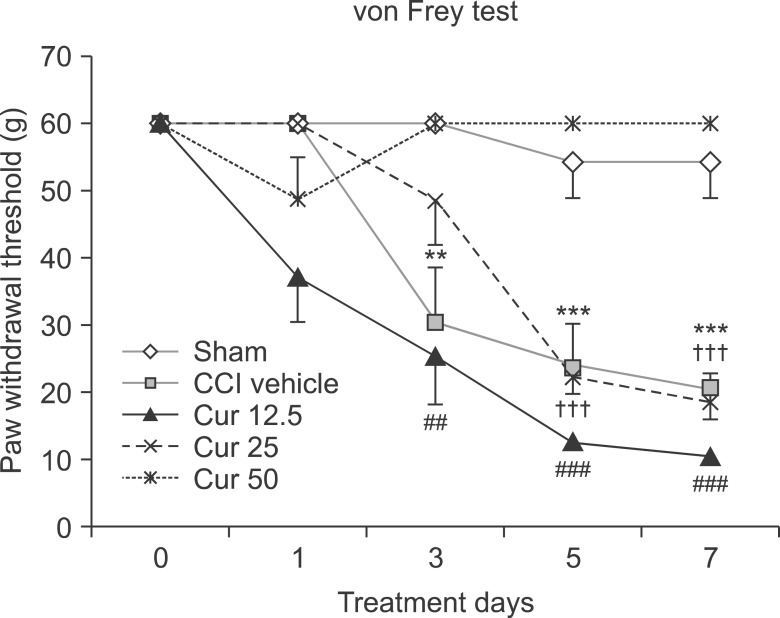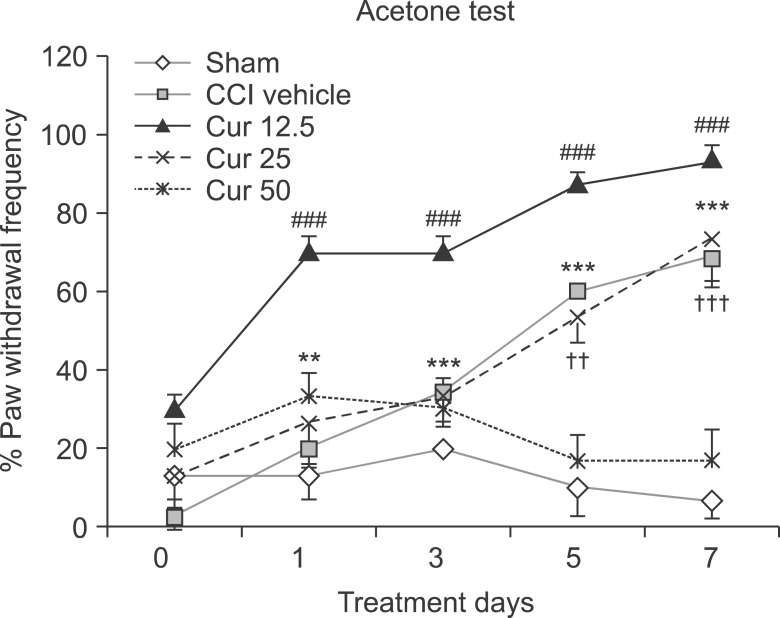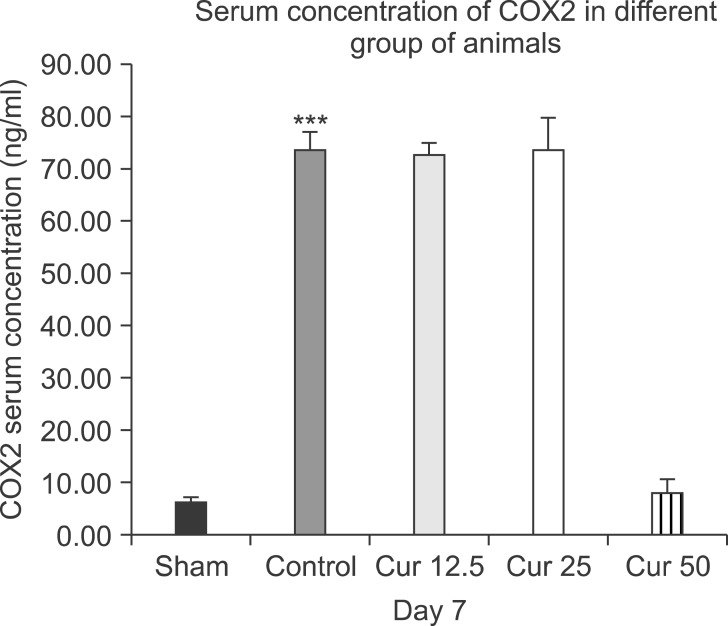Korean J Pain.
2014 Jul;27(3):246-252. 10.3344/kjp.2014.27.3.246.
The Attenuation of Pain Behavior and Serum COX-2 Concentration by Curcumin in a Rat Model of Neuropathic Pain
- Affiliations
-
- 1Department of Pharmacology & Neuroscience Research Center, Shahid Beheshti Medical University, Tehran, Iran. fkasaei@yahoo.com
- 2Department of Immunology, Shahid Beheshti Medical University, Tehran, Iran.
- 3Endocrine Physiology Research Center, Shahid Beheshti Medical University, Tehran, Iran.
- KMID: 2278232
- DOI: http://doi.org/10.3344/kjp.2014.27.3.246
Abstract
- BACKGROUND
Neuropathic pain is generally defined as a chronic pain state resulting from peripheral and/or central nerve injury. There is a lack of effective treatment for neuropathic pain, which may possibly be related to poor understanding of pathological mechanisms at the molecular level. Curcumin, a therapeutic herbal extract, has shown to be effectively capable of reducing chronic pain induced by peripheral administration of inflammatory agents such as formalin. In this study, we aimed to show the effect of curcumin on pain behavior and serum COX-2 level in a Chronic Constriction Injury (CCI) model of neuropathic pain.
METHODS
Wistar male rats (150-200 g, n = 8) were divided into three groups: CCI vehicle-treated, sham-operated, and CCI drug-treated group. Curcumin (12.5, 25, 50 mg/kg, IP) was injected 24 h before surgery and continued daily for 7 days post-surgery. Behavioral tests were performed once before and following the days 1, 3, 5, 7 after surgery. The serum COX-2 level was measured on day 7 after the surgery.
RESULTS
Curcumin (50 mg/kg) decreased mechanical and cold allodynia (P < 0.001) and produced a decline in serum COX-2 level (P < 0.001).
CONCLUSIONS
A considerable decline in pain behavior and serum COX-2 levels was seen in rat following administration of curcumin in CCI model of neuropathic pain. High concentration of Curcumin was able to reduce the chronic neuropathic pain induced by CCI model and the serum level of COX-2.
Keyword
MeSH Terms
Figure
Cited by 3 articles
-
Antinociceptive and neuroprotective effects of bromelain in chronic constriction injury-induced neuropathic pain in Wistar rats
Ahmed Olalekan Bakare, Bamidele Victor Owoyele
Korean J Pain. 2020;33(1):13-22. doi: 10.3344/kjp.2020.33.1.13.Curcumin, COX-2, and Protein p300/CBP
Ki Tae Jung, Kyung Joon Lim
Korean J Pain. 2014;27(4):365-366. doi: 10.3344/kjp.2014.27.4.365.Olanzapine Attenuates Mechanical Allodynia in a Rat Model of Partial Sciatic Nerve Ligation
Taeko Fukuda, Soichiro Yamashita, Setsuji Hisano, Makoto Tanaka
Korean J Pain. 2015;28(3):185-192. doi: 10.3344/kjp.2015.28.3.185.
Reference
-
1. Blackburn-Munro G. Pain-like behaviours in animals - how human are they? Trends Pharmacol Sci. 2004; 25:299–305. PMID: 15165744.
Article2. Zimmermann M. Pathobiology of neuropathic pain. Eur J Pharmacol. 2001; 429:23–37. PMID: 11698024.
Article3. Campbell JN, Meyer RA. Mechanisms of neuropathic pain. Neuron. 2006; 52:77–92. PMID: 17015228.
Article4. Dray A. Neuropathic pain: emerging treatments. Br J Anaesth. 2008; 101:48–58. PMID: 18511441.
Article5. Suzuki R, Dickenson AH. Differential pharmacological modulation of the spontaneous stimulus-independent activity in the rat spinal cord following peripheral nerve injury. Exp Neurol. 2006; 198:72–80. PMID: 16336968.
Article6. Epstein J, Sanderson IR, Macdonald TT. Curcumin as a therapeutic agent: the evidence from in vitro, animal and human studies. Br J Nutr. 2010; 103:1545–1557. PMID: 20100380.
Article7. Sharma S, Kulkarni SK, Agrewala JN, Chopra K. Curcumin attenuates thermal hyperalgesia in a diabetic mouse model of neuropathic pain. Eur J Pharmacol. 2006; 536:256–261. PMID: 16584726.
Article8. Oh SW, Cha JY, Jung JE, Chang BC, Kwon HJ, Lee BR, et al. Curcumin attenuates allergic airway inflammation and hyper-responsiveness in mice through NF-κB inhibition. J Ethnopharmacol. 2011; 136:414–421. PMID: 20643202.
Article9. Sharma S, Chopra K, Kulkarni SK. Effect of insulin and its combination with resveratrol or curcumin in attenuation of diabetic neuropathic pain: participation of nitric oxide and TNF-alpha. Phytother Res. 2007; 21:278–283. PMID: 17199240.
Article10. Mittal N, Joshi R, Hota D, Chakrabarti A. Evaluation of antihyperalgesic effect of curcumin on formalin-induced orofacial pain in rat. Phytother Res. 2009; 23:507–512. PMID: 19051211.
Article11. Chattopadhyay I, Biswas K, Bandyopadhyay U, Banerjee RK. Turmeric and curcumin: biological actions and medicinal applications. Curr Sci. 2004; 87:44–53.12. Stock JL, Shinjo K, Burkhardt J, Roach M, Taniguchi K, Ishikawa T, et al. The prostaglandin E2 EP1 receptor mediates pain perception and regulates blood pressure. J Clin Invest. 2001; 107:325–331. PMID: 11160156.
Article13. Luo C, He ML, Bohlin L. Is COX-2 a perpetrator or a protector? Selective COX-2 inhibitors remain controversial. Acta Pharmacol Sin. 2005; 26:926–933. PMID: 16038624.
Article14. Neuss H, Huang X, Hetfeld BK, Deva R, Henklein P, Nigam S, et al. The ubiquitin- and proteasome-dependent degradation of COX-2 is regulated by the COP9 signalosome and differentially influenced by coxibs. J Mol Med (Berl). 2007; 85:961–970. PMID: 17429597.
Article15. Rainsford KD. Current status of the therapeutic uses and actions of the preferential cyclo-oxygenase-2 NSAID, nimesulide. Inflammopharmacology. 2006; 14:120–137. PMID: 16983492.
Article16. Kimura T, Iwase M, Kondo G, Watanabe H, Ohashi M, Ito D, et al. Suppressive effect of selective cyclooxygenase-2 inhibitor on cytokine release in human neutrophils. Int Immunopharmacol. 2003; 3:1519–1528. PMID: 12946449.
Article17. Rang HP, Dale MM, Ritter JM, Flower RJ. Anti-inflammatory and immunosuppressant drugs. Rang and Dale pharmacology. 6th ed. Edinburgh: Churchill Livingston;2007. p. 232.18. Bryant DM, Alldred A. Rheumatoid arthritis and osteoarthritis. In : Walker R, Whittlesea C, editors. Clinical pharmacy and therapeutics. 4th ed. Edinburgh: Churchill Livingstone;2007. p. 791–812.19. Shishodia S, Sethi G, Aggarwal BB. Curcumin: getting back to the roots. Ann N Y Acad Sci. 2005; 1056:206–217. PMID: 16387689.
Article20. Menon VP, Sudheer AR. Antioxidant and anti-inflammatory properties of curcumin. Adv Exp Med Biol. 2007; 595:105–125. PMID: 17569207.
Article21. Zimmermann M. Ethical guidelines for investigations of experimental pain in conscious animals. Pain. 1983; 16:109–110. PMID: 6877845.
Article22. Bennett GJ, Xie YK. A peripheral mononeuropathy in rat that produces disorders of pain sensation like those seen in man. Pain. 1988; 33:87–107. PMID: 2837713.
Article23. Stuesse SL, Crisp T, McBurney DL, Schechter JB, Lovell JA, Cruce WL. Neuropathic pain in aged rats: behavioral responses and astrocytic activation. Exp Brain Res. 2001; 137:219–227. PMID: 11315551.
Article24. Schaible HG, Ebersberger A, Natura G. Update on peripheral mechanisms of pain: beyond prostaglandins and cytokines. Arthritis Res Ther. 2011; 13:210. PMID: 21542894.
Article25. Kohli K, Ali J, Ansari MJ, Raheman Z. Curcumin: a natural antiinflammatory agent. Indian J Pharmacol. 2005; 37:141–147.
Article26. Lim GP, Chu T, Yang F, Beech W, Frautschy SA, Cole GM. The curry spice curcumin reduces oxidative damage and amyloid pathology in an Alzheimer transgenic mouse. J Neurosci. 2001; 21:8370–8377. PMID: 11606625.
Article27. Li Y, Zhang Y, Liu DB, Liu HY, Hou WG, Dong YS. Curcumin attenuates diabetic neuropathic pain by downregulating TNF-α in a rat model. Int J Med Sci. 2013; 10:377–381. PMID: 23471081.
Article28. Jeon Y, Kim CE, Jung D, Kwak K, Park S, Lim D, et al. Curcumin could prevent the development of chronic neuropathic pain in rats with peripheral nerve injury. Curr Ther Res Clin Exp. 2013; 74:1–4. PMID: 24385078.
Article29. Kim CE, Park ES, Jeon YH. Curcumin attenuates chronic constriction nerve injury-induced neuropathic pain in rats. Korean J Med Crop Sci. 2008; 16:183–187.30. Han YK, Lee SH, Jeong HJ, Kim MS, Yoon MH, Kim WM. Analgesic effects of intrathecal curcumin in the rat formalin test. Korean J Pain. 2012; 25:1–6. PMID: 22259709.
Article31. Bengmark S. Curcumin, an atoxic antioxidant and natural NFkappaB, cyclooxygenase-2, lipooxygenase, and inducible nitric oxide synthase inhibitor: a shield against acute and chronic diseases. JPEN J Parenter Enteral Nutr. 2006; 30:45–51. PMID: 16387899.
Article32. Yeon KY, Kim SA, Kim YH, Lee MK, Ahn DK, Kim HJ, et al. Curcumin produces an antihyperalgesic effect via antagonism of TRPV1. J Dent Res. 2010; 89:170–174. PMID: 20040737.
Article33. Tajik H, Tamaddonfard E, Hamzeh-Gooshchi N. Interaction between curcumin and opioid system in the formalin test of rats. Pak J Biol Sci. 2007; 10:2583–2586. PMID: 19070135.
Article34. Chainani-Wu N. Safety and anti-inflammatory activity of curcumin: a component of tumeric (Curcuma longa). J Altern Complement Med. 2003; 9:161–168. PMID: 12676044.
Article35. Orlando RA, Gonzales AM, Hunsaker LA, Franco CR, Royer RE, Vander Jagt DL, et al. Inhibition of nuclear factor kappaB activation and cyclooxygenase-2 expression by aqueous extracts of Hispanic medicinal herbs. J Med Food. 2010; 13:888–895. PMID: 20482259.
Article36. Tegeder I, Niederberger E, Vetter G, Bräutigam L, Geisslinger G. Effects of selective COX-1 and -2 inhibition on formalinevoked nociceptive behaviour and prostaglandin E(2) release in the spinal cord. J Neurochem. 2001; 79:777–786. PMID: 11723170.
Article37. Vanegas H, Schaible HG. Prostaglandins and cyclooxygenases [correction of cycloxygenases] in the spinal cord. Prog Neurobiol. 2001; 64:327–363. PMID: 11275357.38. Kang G, Kong PJ, Yuh YJ, Lim SY, Yim SV, Chun W, et al. Curcumin suppresses lipopolysaccharide-induced cyclooxygenase-2 expression by inhibiting activator protein 1 and nuclear factor kappab bindings in BV2 microglial cells. J Pharmacol Sci. 2004; 94:325–328. PMID: 15037818.
Article39. Hinz B, Brune K. Cyclooxygenase-2--10 years later. J Pharmacol Exp Ther. 2002; 300:367–375. PMID: 11805193.
Article
- Full Text Links
- Actions
-
Cited
- CITED
-
- Close
- Share
- Similar articles
-
- Curcumin, COX-2, and Protein p300/CBP
- Development of Neuropathic Pain Model with 1% Phenol Injection in Rat Sciatic Nerve
- Curcumin and Its Emerging Role in Pain Modulation and Pain Management
- Analgesic Effects of Intrathecal Curcumin in the Rat Formalin Test
- Pharmacological interactions between intrathecal pregabalin plus tianeptine or clopidogrel in a rat model of neuropathic pain





